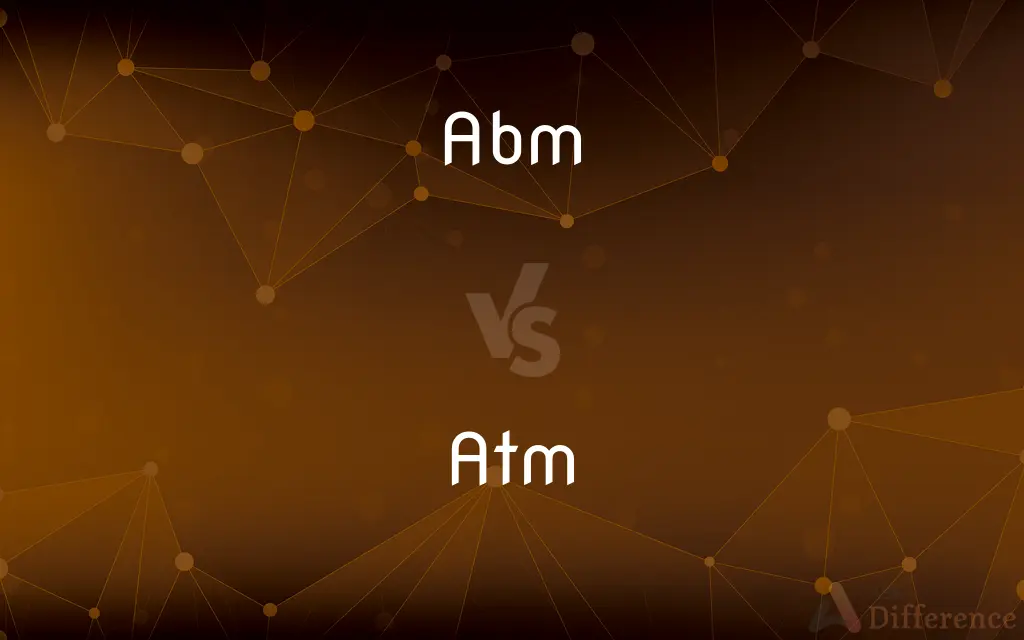Abm vs. Atm — What's the Difference?
By Fiza Rafique & Urooj Arif — Updated on April 7, 2024
ABM stands for Anti-Ballistic Missile, a defense system against ballistic missiles, while ATM means Automated Teller Machine, a banking terminal for financial transactions.

Difference Between Abm and Atm
Table of Contents
ADVERTISEMENT
Key Differences
ABM, or Anti-Ballistic Missile, refers to missile defense systems designed to intercept and destroy incoming ballistic missiles. On the other hand, ATM, standing for Automated Teller Machine, is a banking terminal that allows customers to perform financial transactions, such as cash withdrawals and deposits, without the need for a human cashier.
While ABMs are part of military defense strategies and involve sophisticated radar and missile technology to protect against external threats, ATMs are integral to the banking and financial industry, providing convenience and accessibility to banking services for the public.
The development and deployment of ABMs require significant investment in research, technology, and infrastructure, aiming to enhance national security. Whereas, ATMs are developed by financial institutions to improve customer service, reduce operational costs, and extend banking services beyond traditional branch hours.
ABMs operate within a complex system of sensors, radars, and interception technologies to track, target, and neutralize enemy missiles. ATMs, however, rely on secure network connections, encryption, and user authentication to process transactions safely.
The success and effectiveness of ABMs are measured by their ability to deter threats and protect against missile attacks, highlighting their strategic importance. In contrast, the success of ATMs is gauged by their reliability, user-friendliness, and the extent to which they facilitate everyday financial transactions for users.
ADVERTISEMENT
Comparison Chart
Definition
A defense system against ballistic missiles
A banking terminal for financial transactions
Primary Function
Intercepts and destroys incoming ballistic missiles
Allows customers to perform financial transactions
Industry
Military defense
Banking and finance
Technological Focus
Radar, missile technology, interception mechanisms
Secure network connections, encryption, user authentication
Success Measurement
Ability to deter threats and protect against attacks
Reliability, user-friendliness, accessibility
Compare with Definitions
Abm
Defense System.
ABMs are designed to protect against ballistic missile threats.
Atm
Banking Convenience.
ATMs offer 24/7 access to banking services, enhancing customer convenience.
Abm
Military Technology.
ABM systems involve advanced radar and missile interception technologies.
Atm
Financial Transaction Terminal.
ATMs enable users to withdraw cash and perform other banking transactions.
Abm
National Security Tool.
ABMs contribute significantly to a nation's defense capabilities.
Atm
Operational Efficiency.
ATMs reduce the need for tellers and customer wait times at banks.
Abm
Strategic Deployment.
The placement of ABM systems is strategically decided based on threat assessments.
Atm
Secure Transactions.
ATMs use encryption and PIN codes to ensure transaction security.
Abm
High Investment.
Developing and maintaining ABM systems require substantial investment.
Atm
Widespread Accessibility.
ATMs are located in various accessible locations beyond bank branches.
Abm
A defensive missile designed to shoot down incoming intercontinental ballistic missiles;
The Strategic Arms Limitation Talks placed limits on the deployment of ABMs
Atm
An unattended electronic machine in a public place, connected to a data system and related equipment and activated by a bank customer to obtain cash withdrawals and other banking services.
Atm
A unit of pressure: the pressure that will support a column of mercury 760 mm high at sea level and 0 degrees centigrade
Atm
A means of digital communications that is capable of very high speeds; suitable for transmission of images or voice or video as well as data;
ATM is used for both LAN and WAN
Atm
An unattended machine (outside some banks) that dispenses money when a personal coded card is used
Common Curiosities
What does ATM stand for?
ATM stands for Automated Teller Machine, a device that facilitates automated banking transactions.
What industries utilize ABMs and ATMs?
The military defense industry utilizes ABMs, while the banking and finance industry employs ATMs.
What is the significance of ABM systems?
ABMs are crucial for national security, offering protection against missile threats.
How do ATMs enhance banking services?
ATMs provide 24/7 banking services, allowing users to perform transactions without bank tellers.
How do ABMs and ATMs differ in function?
ABMs are used for national defense to intercept missiles, whereas ATMs are used for conducting financial transactions.
Can ABMs protect against all types of missiles?
ABMs are specifically designed to intercept ballistic missiles, not all missile types.
What challenges do ABMs face?
ABMs face challenges such as detecting and intercepting advanced missile technologies and decoys.
What is an ABM?
An ABM (Anti-Ballistic Missile) is a missile defense system designed to intercept and neutralize ballistic missiles.
How has the deployment of ATMs impacted banking?
ATMs have significantly improved operational efficiency and customer convenience in banking.
How do nations justify the cost of ABM systems?
The justification lies in the strategic importance of national defense and missile deterrence.
What features ensure the security of ATM transactions?
Encryption, secure network connections, and user authentication protect ATM transactions.
What is the future of ABM technology?
The future may include more advanced radar systems, AI integration, and space-based interception capabilities.
What advances have been made in ATM technology?
Advances include touchless transactions, biometric security, and multi-currency dispensing.
What technological components are crucial for ABMs?
Advanced radar, missile technology, and interception mechanisms are vital for ABMs.
Are ATMs available in all regions?
ATMs are widely available but might be less accessible in extremely remote areas.
Share Your Discovery

Previous Comparison
Protoboard vs. Breadboard
Next Comparison
Lift vs. HoistAuthor Spotlight
Written by
Fiza RafiqueFiza Rafique is a skilled content writer at AskDifference.com, where she meticulously refines and enhances written pieces. Drawing from her vast editorial expertise, Fiza ensures clarity, accuracy, and precision in every article. Passionate about language, she continually seeks to elevate the quality of content for readers worldwide.
Co-written by
Urooj ArifUrooj is a skilled content writer at Ask Difference, known for her exceptional ability to simplify complex topics into engaging and informative content. With a passion for research and a flair for clear, concise writing, she consistently delivers articles that resonate with our diverse audience.














































